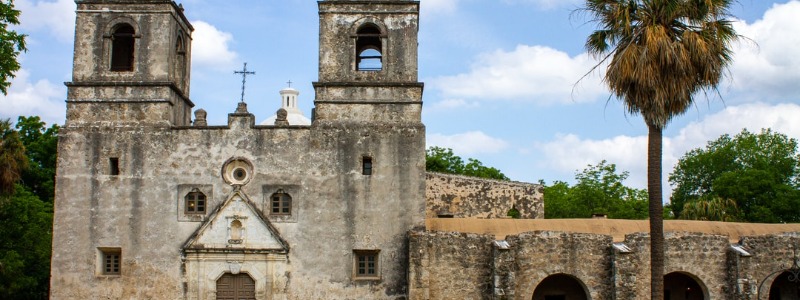Visit Old Spanish Missions in San Antonio TX
Contents
San Antonio, Texas is a city rich in history and culture. Located in the heart of South Texas, San Antonio is home to five Spanish colonial missions that date back over 300 years. These five missions: Concepción, San José, San Juan Capistrano, Espada, and the Alamo are now part of the National Park Service and serve as some of the most iconic attractions in South Texas.
Four of the five original missions still function as active Catholic parish Churches. They serve both a stable population of parish members as well as many visitors who attend worship services. These are Concepcion, San Jose, San Juan and Espada. They are operated by the Roman Catholic Archdiocese of San Antonio as the Old Spanish Missions, Inc., an umbrella non-profit organization to provide for their care. The Archbishop of San Antonio appoints the Director of the Old Spanish Missions, who is responsible for the maintenance and restoration of the mission churches.
San Antonio Missions National Historical Park
6701 San Jose Dr, San Antonio, TX 78214
The San Antonio Missions National Historical Park is a good place to start if you are interested in visiting these remarkable historical landmarks. The missions, along with the Alamo, have been named a World Heritage Site by the United Nations Organization for Education, Science and Culture (UNESCO).
The park’s Visitor’s Center is in Mission San José, where you can view the film Gente de Razon, which tells the story of life in the missions during the 1700s. The film is shown every 30 minutes. Mission San José also has a museum and bookstore. All four mission churches still have active Catholic parishes that hold regular services. The churches are open to visitors during regular park hours.
Mission Reach Paddling Trail
Trailhead: 2639 De Sague St, San Antonio, TX 78214
As a bonus now you can explore the Missions along the River Walk’s new Mission Reach. The Mission Reach is an eight-mile stretch with recreational trails, picnic and seating areas, pedestrian bridges, pavilions, and portals to four Spanish colonial missions—Concepción, San José, San Juan, and Espada. End your journey with a trip to the Alamo downtown.
Here is a rundown of the four historic missions and a look at the history of the Alamo.
Mission San José
6701 San Jose Dr, San Antonio, TX 78214
Mission San José y San Miguel de Aguayo, to give its full name, is one of the five Spanish missions established by Franciscan missionaries along the San Antonio River between 1718 and 1731 to convert Native Americans to Christianity and to reinforce Spanish territorial claims.
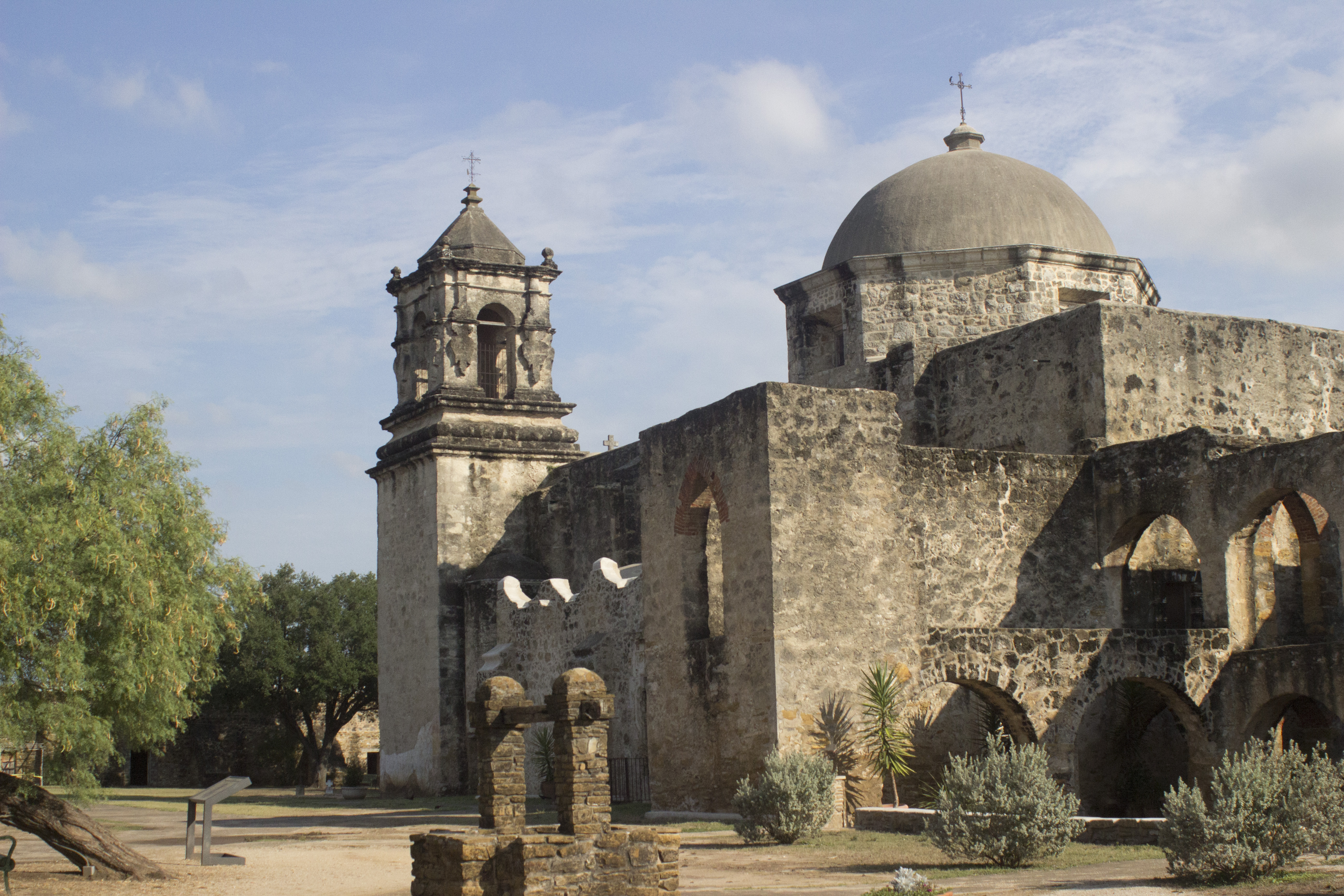
Intended as self-sufficient settlements, each mission housed hundreds of American Indians under the strict supervision of Franciscan priests and the protection of Spanish soldiers. In exchange for food and security from marauding Lipan Apaches, some Native Americans agreed to live in the mission, work on a regimented schedule and receive religious instruction. Last year UNESCO designated the five missions as Texas’ first World Heritage Site.
San José y San Miguel de Aguayo, the “Queen of the Missions,” is the largest mission in San Antonio, established in 1720 and completed in 1782. Spanish designers, directing workers from the local Coahuiltecan tribe, built the mission using Texas limestone and brightly colored stucco. At its height, it provided sanctuary and a social and cultural community for more than 300 Indians and was surrounded by acres of fields and livestock herds. The mission had its own gristmill and granary, which have been preserved.
In 1874, San José’s church dome and the roof collapsed. In 1928, the church tower collapsed. The Works Progress Administration (WPA) almost fully restored Mission San José to its original design in the 1930s.
Thanks to a painstaking restoration carried out by the Works Progress Administration in the 1930s, it looks much as it did when it was completed in the 18th century. Surrounded by thick, 10-foot-high stone walls to repel Apache attacks, the 8-acre open-air compound was used for cooking and military training. Built against the walls are reproductions of the spare, low-ceilinged living quarters where most of the mission’s several hundred Indians dwelled.
When visiting the church, look for flying buttresses, carvings, quatrefoil patterns, polychromatic plaster, and the famed “Rose Window,” a superb example of Spanish Colonial ornamentation that was sculpted around 1775. Explore the stairway that leads to the belfry and choir loft; all 25 risers were hand-hewn from a single log and assembled without the use of nails or pegs.
On the north side of the complex are the mission’s most important buildings, the Convento, where the missionaries and important visitors lived, and the church, which features a domed nave, a bell tower, and an elaborately carved baroque entrance façade. Built into the south wall of the church is the stunning Rose Window, considered the finest example of colonial Spanish stone decoration in the U.S. Although the church’s dome collapsed in 1873, it has since been fully restored, and San José is now an active Catholic parish that hosts weekly services, including its famous mariachi Mass.
Mission Concepción
807 Mission Rd, San Antonio, TX 78210
The beautiful church at Mission Nuestra Señora de la Purisima Concepción de Acuña looks much like it did in 1755 when it was first dedicated. Interior renovations in 2010 returned the church’s interior walls to the rich colors of 255 years earlier.

The church’s exterior was originally decorated with geometric designs painted on the façade and iron crosses and weather vanes were placed atop the two towers. The exterior paintings have faded, but inside you can still see original frescos in some of the rooms. The church stands as the oldest unrestored stone church in the U.S.
Mission San Juan
9101 Graf Rd, San Antonio, TX 78214
Mission San Juan was established in San Antonio in 1731. The church, priest’s quarters, and granary were completed in 1756. The mission’s fertile farmlands allowed for a self-sustainable community, and its surplus helped supply the region with produce.
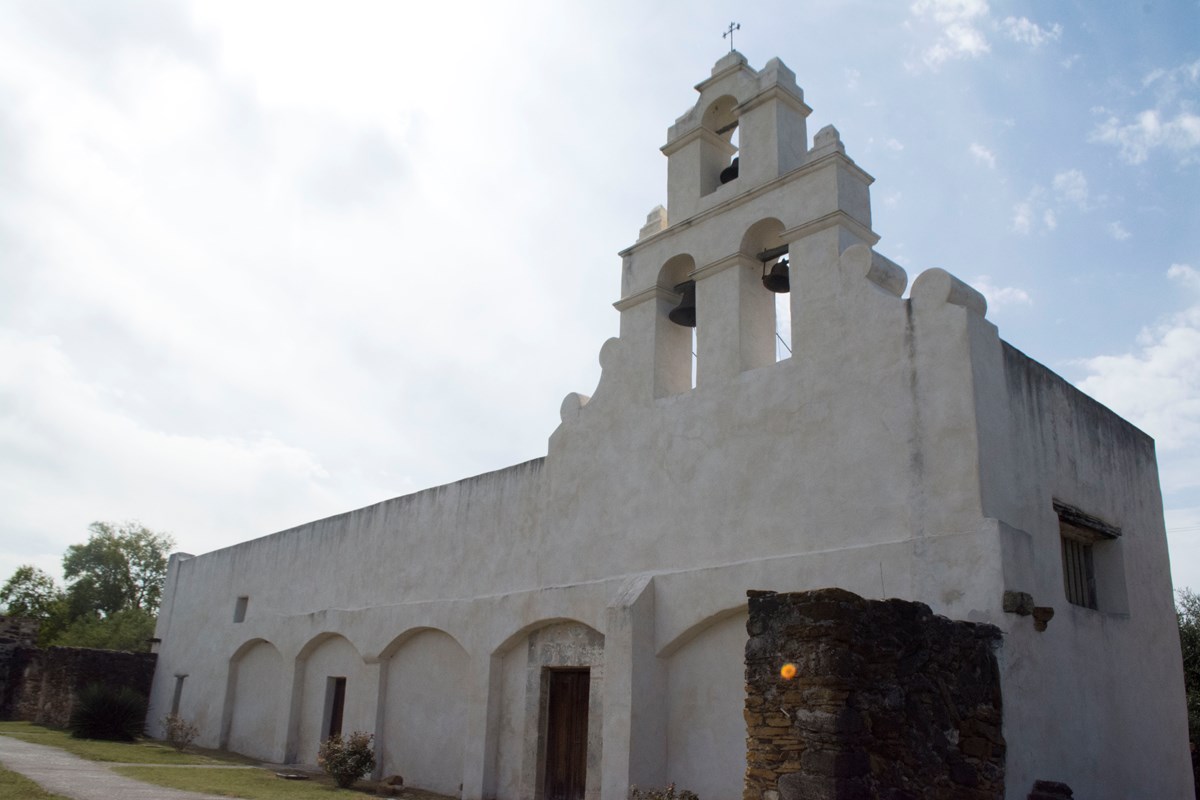
The chapel and bell tower are still in use. Note the typical Romanesque archway at the entrance gate and the remains of a half-completed, more elaborate church that was begun in 1772 and abandoned in 1786 when the mission’s population declined. Guests can also tour a self-guided nature trail that leads to the river.
Mission Espada
9942, 10328 Espada Rd, San Antonio, TX 78214
Mission San Francisco de la Espada, the southernmost of the four in the park, contains the best-preserved segment of the acequia (irrigation system) that was used to bring water to the fields. Today, part of the acequia operates the Espada aqueduct and dam. Also noteworthy are an unusual door and stone archway.
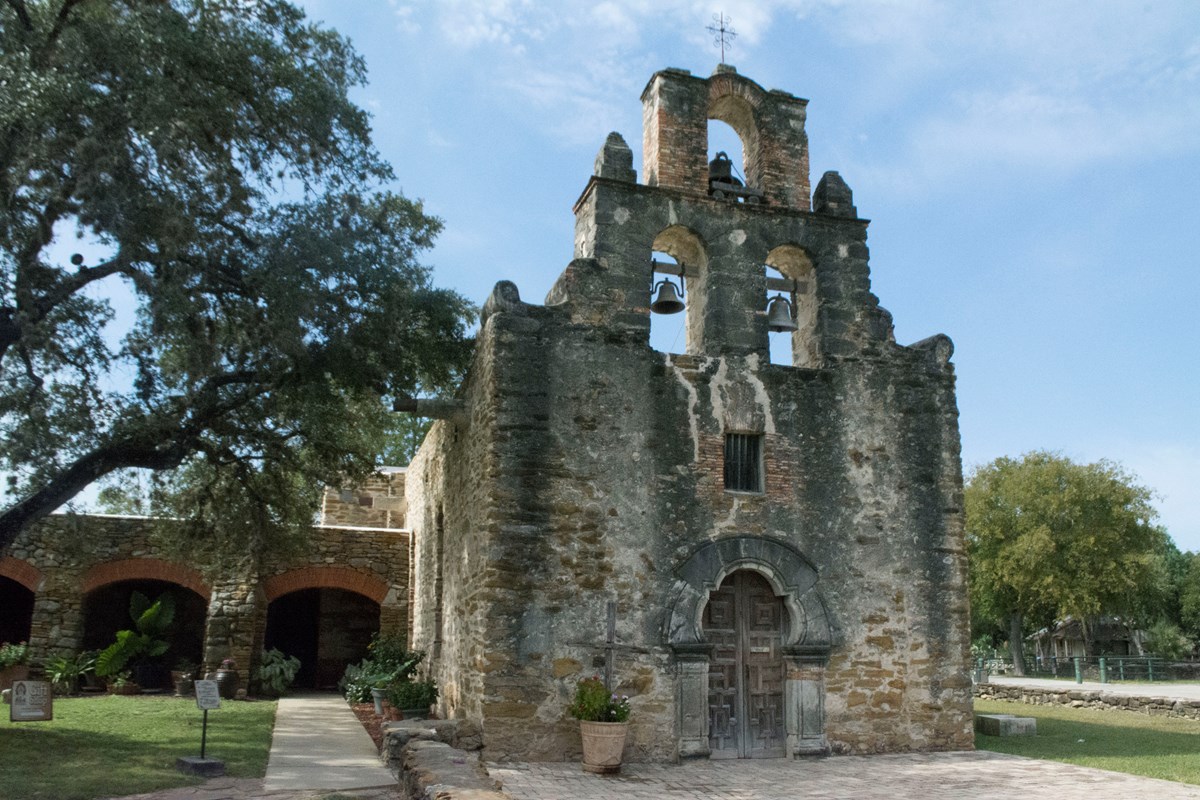
The mission was established in San Antonio in 1731. The priest’s residence was completed in 1745 and the church in 1756. Inside the mission, the compound was a blacksmith shop, a kiln for baking brick, and workrooms with looms and spinning wheels. Corn, beans, melons, pumpkins, and cotton were grown in the irrigated fields adjacent to the mission.
The Alamo
300 Alamo Plaza, San Antonio, TX 78205
San Antonio de Valero, known as the Alamo, is owned by the State of Texas and operated by the Daughters of the Republic of Texas. It does not function as an active parish church and is not part of the Old Spanish Missions corporation. But added to the other Missions of the city, it offers travelers and visitors an excellent opportunity to explore the history of Spanish involvement and impact on the New World.
Unfortunately, the Alamo is also one of the worst-preserved missions. Originally a 3-acre walled compound, it suffered over the centuries from war, neglect, and encroaching development. Virtually all that remains today is the church, with its signature curved gable pediment — and even that was only added in 1850 by the U.S. Army to disguise the peak of the church’s new wooden roof.
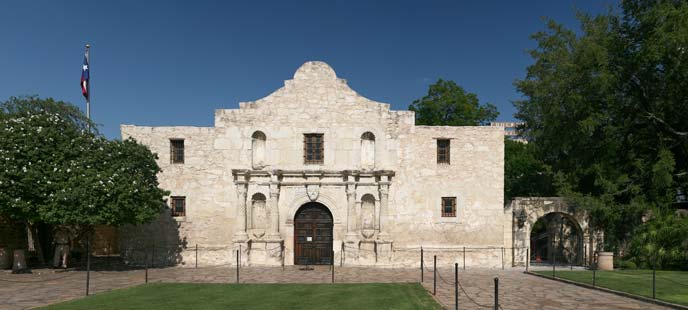
According to History.com, Spanish settlers built the Mission San Antonio de Valero on the banks of the San Antonio River. The year was 1718. In addition, they also established the nearby military garrison of San Antonio de Béxar, which soon became the center of a settlement that would later be known as San Antonio. The Mission San Antonio de Valero housed missionaries and Native American converts for nearly a century in the late 1700s when Spanish authorities secularized the five missions located there.
In the early 1800s, Spanish military troops were stationed in the abandoned chapel of the former mission. Because it stood in a grove of cottonwood trees, the soldiers called their new fort “El Alamo” after the Spanish word for cottonwood and in honor of Alamo de Parras, their hometown in Mexico. Military troops–first Spanish, then rebel, and later Mexican–occupied the Alamo during and after Mexico’s successful war for independence from Spain in the early 1820s. In the summer of 1821, Stephen Austin arrived in San Antonio along with some 300 U.S. families that the Spanish government had allowed settling in Texas. The migration of U.S. citizens to Texas increased over the next decades, sparking a revolutionary movement that would erupt into armed conflict by the mid-1830s.
It was then the Texans began to exercise their desire for independence, resulting eventually in the articles of independence drafted at Washington-on-the-Brazos, signaling the start of a conflict that would lead to the historic battle of the Alamo. Greatly outnumbered, defenders of the Alamo fell to a large Mexican Army, but a few months later the Texians routed that Army at the Battle of San Jacinto, winning the day and the New Republic’s independence.
History of the Missions
Everyone remembers the Alamo, Texas’ most famous landmark, but few make their way to the four other colonial missions in San Antonio.
In the year 1718, Ben Franklin was a fledging 12-year-old boy growing up in Boston and knew very little about American colonists’ plight with England’s Crown. That same year, two of the new World’s oldest cities were founded, New Orleans (by the French) and San Antonio (by the Spanish). Relative to the latter, it was also the year that construction began on the Mission of San Antonio de Valero, later known as the Alamo.
Fourteen years later, the second and larger Mission Nuestra Señora de la Purísima Concepción de Acuña was moved into its new building in San Antonio, shortly before construction began on the Queen of all New World mission at the time, Mission San José y San Miguel de Agua.
It was the beginning of Spanish exploration into new territories of North America and symbolized Spain’s intent to dominate cultural and governing dominance in the New World, an effort that hardly ended with the construction of Mission San Jose.
It all started in Texas in the year 1632 when Spanish friars traveled north from Mexico into the area and constructed dozens of missions and presidios, or military forts). The goal of the Franciscan friars was to spread the Catholic faith by converting the native Indians. The missions were supported by the Spanish colonial government, which saw them as a means of spreading Spanish influence and claiming territory.
Many of the missions, especially in the south and eastern portions of Texas, grew into thriving settlements that formed the basis of some of the state’s most important cities, but nowhere more so than in San Antonio de Bexar, the cradle of Spanish domination in Texas and later, the shrine city of the fight for Texas Independence at the Alamo.
So many missions were constructed in the vicinity of San Antonio that many mission locations have been lost and forgotten. Even so, the remaining Missions of San Antonio represent what is arguably the Spanish mission capital of America. The Old Spanish Missions of San Antonio in modern times are represented by a chain of five colonial-era compounds located in a southern line from the center of downtown San Antonio to the southern edge of the city.
Missions in San Antonio
Each mission offers multiple tours and activities for visitors to explore during their stay. From exploring guided hikes around each mission’s grounds to visiting interactive museums with artifacts from centuries past, these tours give visitors a unique look into what life was like for those who lived at these missions centuries before us. Visitors also have access to lectures from knowledgeable experts who can provide an even deeper understanding of these sites’ historical importance.

